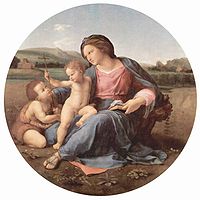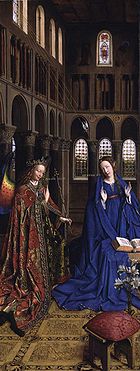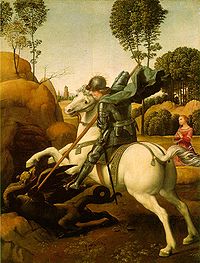
Soviet sale of Hermitage paintings
Encyclopedia



Leningrad
Leningrad is the former name of Saint Petersburg, Russia.Leningrad may also refer to:- Places :* Leningrad Oblast, a federal subject of Russia, around Saint Petersburg* Leningrad, Tajikistan, capital of Muminobod district in Khatlon Province...
to western museums. Several of the paintings had been in the Hermitage Collection since its creation by Empress Catherine the Great. About two hundred and fifty paintings were sold, including fifty masterpieces by Van Eyck
Van Eyck
Van Eyck , also Van Eijk is a Dutch surname meaning "of Eyck" or "of Eijk"...
, Titian
Titian
Tiziano Vecelli or Tiziano Vecellio Tiziano Vecelli or Tiziano Vecellio Tiziano Vecelli or Tiziano Vecellio (c. 1488/1490 – 27 August 1576 better known as Titian was an Italian painter, the most important member of the 16th-century Venetian school. He was born in Pieve di Cadore, near...
, Rembrandt, Rubens
Rubens
Rubens is often used to refer to Peter Paul Rubens , the Flemish artist.Rubens may also refer to:- People :Family name* Paul Rubens Rubens is often used to refer to Peter Paul Rubens (1577-1640), the Flemish artist.Rubens may also refer to:- People :Family name* Paul Rubens (composer) Rubens is...
, Raphael
Raphael
Raffaello Sanzio da Urbino , better known simply as Raphael, was an Italian painter and architect of the High Renaissance. His work is admired for its clarity of form and ease of composition and for its visual achievement of the Neoplatonic ideal of human grandeur...
, and other important artists. Andrew Mellon donated the twenty-one paintings he purchased from the Hermitage to the United States Government in 1937. They became the nucleus of the National Gallery of Art
National Gallery of Art
The National Gallery of Art and its Sculpture Garden is a national art museum, located on the National Mall between 3rd and 9th Streets at Constitution Avenue NW, in Washington, DC...
in Washington DC.
History
In the late 1920s, the Soviet government urgently needed foreign currency to finance the rapid industrialization of Russia ordered in the first Five Year Plan. The government had already sold off collections of jewelry, furniture and icons seized from the Russian nobility, wealthy classes, and the church.In February 1928, the State Hermitage Museum in Leningrad
Leningrad
Leningrad is the former name of Saint Petersburg, Russia.Leningrad may also refer to:- Places :* Leningrad Oblast, a federal subject of Russia, around Saint Petersburg* Leningrad, Tajikistan, capital of Muminobod district in Khatlon Province...
, along with the Russian Museum
Russian Museum
The State Russian Museum is the largest depository of Russian fine art in St Petersburg....
, was ordered to make a list of art works worth at least two million rubles, for export. A special agency called 'Antiquariat' was created under the Narkompros (the People's Commisariat of Enlightenment) and opened an office in Leningrad to oversee the sale. The Hermitage was instructed to sell 250 paintings for at least 5000 rubles each, plus engravings and a number of golden treasures from ancient Scythia
Scythia
In antiquity, Scythian or Scyths were terms used by the Greeks to refer to certain Iranian groups of horse-riding nomadic pastoralists who dwelt on the Pontic-Caspian steppe...
.
The sale was secret, but word was quietly spread to selected western art dealers and collectors that the paintings were on the market.
The first foreign buyer to purchase Hermitage paintings was Calouste Gulbenkian
Calouste Gulbenkian
Calouste Sarkis Gulbenkian was an Armenian businessman and philanthropist. He played a major role in making the petroleum reserves of the Middle East available to Western development...
, the founder of the Iraq Petroleum Company, who began buying paintings in early 1930, trading them for oil with the Russians. The organizers of the sale were dissatisfied with the amounts they received from Gulbenkian, so they looked for other buyers.
Franz Zatzenstein-Matthiesen, a young German art dealer, was asked by the Soviet Government to compile a list of the hundred paintings in Russian collections, which should never be sold under any circumstances. He was most surprised to be shown several of these paintings not long after in Paris
Paris
Paris is the capital and largest city in France, situated on the river Seine, in northern France, at the heart of the Île-de-France region...
by Gulbenkian. Gulbenkian wanted him to act as his agent on further purchases, but Matthiesen instead formed a consortium with Colnaghi's of London and Knoedler & Co of New York, which in 1930 and 1931 bought twenty-one paintings from the Russians, all of which were bought by Andrew Mellon, who had been offered first refusal.
Andrew Mellon, an American banker, Secretary of the Treasury for Presidents Warren Harding, Calvin Coolidge
Calvin Coolidge
John Calvin Coolidge, Jr. was the 30th President of the United States . A Republican lawyer from Vermont, Coolidge worked his way up the ladder of Massachusetts state politics, eventually becoming governor of that state...
and Herbert Hoover
Herbert Hoover
Herbert Clark Hoover was the 31st President of the United States . Hoover was originally a professional mining engineer and author. As the United States Secretary of Commerce in the 1920s under Presidents Warren Harding and Calvin Coolidge, he promoted partnerships between government and business...
, art collector and, at the time, American Ambassador to Great Britain, had conceived the idea of founding a National Gallery for the United States modelled after the National Gallery in London. He heard about the Hermitage sale through the art gallery he usually used for his purchases, the Knoedler Gallery of New York, Paris and London.

Annunciation (van Eyck, Washington)
The Annunciation is an oil painting by the Early Netherlandish master Jan van Eyck, from around 1434-1436. It is in the National Gallery of Art, in Washington D.C. It was originally on panel but has been transferred to canvas. It is thought that it was the left wing of a triptych; there has...
and Raphael's The Alba Madonna. The latter painting was sold for $1,166,400, the largest sum ever paid for a single painting until that time.
By the end of 1931, Mellon had acquired twenty-one paintings for a total price of $6,654,000. He donated these paintings in 1937 to the United States, along with the money to build a museum to house them. These paintings were the heart of the National Gallery's collection.
The sale was secret until November 4, 1933, when it was reported in the New York Times that several Hermitage paintings had been purchased by the Metropolitan Museum in New York.
The sale came to an end in 1934, possibly as a result of a letter to Stalin from the deputy director of the Hermitage, Joseph Orbeli
Joseph Orbeli
Joseph Orbeli , 1887 – February 2, 1961) was a renowned Soviet orientalist and academician of Armenian descent who specialized in medieval history of Southern Caucasus and administered the State Hermitage Museum in Leningrad from 1934 to 1951...
, protesting the sale of Russia's treasures. The director of the Hermitage, Boris Legran
Boris Legran
Boris Vasilyevich Legran or Legrand was a Bolshevik revolutionary and Soviet official who represented the interests of the Russian SFSR in Armenia and Transcaucasia, during the 1920s and worked as a consular official in China during the 1920s.He also was the director of the State Hermitage Museum...
, who had been brought to the museum to conduct the sale, was dismissed in 1934 and replaced by Orbeli.
In the 1990s, following the breakup of the Soviet Union, the Parliament of the Russian Federation passed a new law prohibiting the sale of Russian art treasures to foreign countries.
For many years the National Gallery was reluctant to loan the paintings it had bought from the Hermitage back to that Museum, for fear that the Russian government would keep the paintings in Russia. That policy changed after 1990, when Mikhail Piotrovsky
Mikhail Piotrovsky
Mikhail Borisovich Piotrovsky is the Director of the State Hermitage Museum in Saint Petersburg. He was born in Yerevan in the Armenian Soviet Socialist Republic on 9 November 1944 to Boris Piotrovsky, a notable Orientalist and himself the future Director of the Hermitage, and Armenian mother...
became director of the Hermitage. A number of the National Gallery paintings have been on loan to the Hermitage, including Venus with a Mirror by Titian
Titian
Tiziano Vecelli or Tiziano Vecellio Tiziano Vecelli or Tiziano Vecellio Tiziano Vecelli or Tiziano Vecellio (c. 1488/1490 – 27 August 1576 better known as Titian was an Italian painter, the most important member of the 16th-century Venetian school. He was born in Pieve di Cadore, near...
, which was lent to the Hermitage at the time of the first visit of the President George W. Bush
George W. Bush
George Walker Bush is an American politician who served as the 43rd President of the United States, from 2001 to 2009. Before that, he was the 46th Governor of Texas, having served from 1995 to 2000....
to St Petersburg in 2002.
Timeline
February 1928Hermitage ordered to prepare list of paintings for sale.
January 1930
- Antoine WatteauAntoine WatteauJean-Antoine Watteau was a French painter whose brief career spurred the revival of interest in colour and movement...
, The Lute Player (sold to Calouste Gulbenkian.) - Rembrandt van Rijn, Portrait of Titus, (sold to Calouste Gulbenkian)
- Anthony van DyckAnthony van DyckSir Anthony van Dyck was a Flemish Baroque artist who became the leading court painter in England. He is most famous for his portraits of Charles I of England and his family and court, painted with a relaxed elegance that was to be the dominant influence on English portrait-painting for the next...
, Susanna Fourment and her daughter (sold to Mellon syndicate) - Anthony Van Dyck, Portrait of Philip, Lord Wharton (sold to Mellon syndicate)
May 1930
- Nicolas LancretNicolas LancretNicolas Lancret , French painter, was born in Paris, and became a brilliant depicter of light comedy which reflected the tastes and manners of French society under the regent Orleans....
, The Beautiful Bathers, (sold to Calouste Gulbenkian, then resold to George Wildenstein. Now in a private collection.)
June 1930
- Jan Van EyckJan van EyckJan van Eyck was a Flemish painter active in Bruges and considered one of the best Northern European painters of the 15th century....
, The AnnunciationAnnunciation (van Eyck, Washington)The Annunciation is an oil painting by the Early Netherlandish master Jan van Eyck, from around 1434-1436. It is in the National Gallery of Art, in Washington D.C. It was originally on panel but has been transferred to canvas. It is thought that it was the left wing of a triptych; there has...
, (sold to Mellon syndicate for $502,899.)
July 1930
- Anthony van Dyck, Portrait of Isabella Brandt (sold to Mellon syndicate for $223,000.)
October 1930
- Rembrandt van Rijn, Portrait of an Old Man, (sold to Gulbenkian for 30,000 pounds sterling Museu Calouste GulbenkianMuseu Calouste GulbenkianMuseu Calouste Gulbenkian is a museum in Lisbon, Portugal, containing a collection of ancient, and some modern art...
, Lisboa, PortugalPortugalPortugal , officially the Portuguese Republic is a country situated in southwestern Europe on the Iberian Peninsula. Portugal is the westernmost country of Europe, and is bordered by the Atlantic Ocean to the West and South and by Spain to the North and East. The Atlantic archipelagos of the...
)
November 1930
- Adriaen HannemanAdriaen HannemanAdriaen Hanneman was a Dutch Golden Age painter best-known today for his portraits of the exiled British royal court. His style was strongly influenced by his contemporary, Anthony Van Dyck.-Biography:...
, Portrait of Henry, Duke of Gloucester (sold to Mellon syndicate) - VeronesePaolo VeronesePaolo Veronese was an Italian painter of the Renaissance in Venice, famous for paintings such as The Wedding at Cana and The Feast in the House of Levi...
, The Finding of Moses (sold to Mellon syndicate)
January, 1931
- Rembrandt van Rijn, Joseph Accused by the Wife of Potiphar (sold to Mellon syndicate)
February 1931
- Frans Hals, Portrait of a Young Man (Mellon syndicate).
- Rembrandt van Rijn, Woman with a Pink (Mellon syndicate).
- Rembrandt van Rijn, Portrait of a Polish Nobleman, (Mellon syndicate).
- RaphaelRaphaelRaffaello Sanzio da Urbino , better known simply as Raphael, was an Italian painter and architect of the High Renaissance. His work is admired for its clarity of form and ease of composition and for its visual achievement of the Neoplatonic ideal of human grandeur...
, Saint George and the Dragon. (Mellon Syndicate) - VelázquezDiego VelázquezDiego Rodríguez de Silva y Velázquez was a Spanish painter who was the leading artist in the court of King Philip IV. He was an individualistic artist of the contemporary Baroque period, important as a portrait artist...
.
Portrait of Pope Innocent X
Portrait of Innocent X
The Portrait of Pope Innocent X is an oil on canvas portrait by the Spanish painter Diego Velázquez, finished during a trip to Italy around 1650. Many artists and art critics consider it the finest portrait ever created. It is housed in the Galleria Doria Pamphilj in Rome...
(Mellon Syndicate; the New York version)
- Sandro BotticelliSandro BotticelliAlessandro di Mariano di Vanni Filipepi, better known as Sandro Botticelli was an Italian painter of the Early Renaissance...
, The Adoration of the Magi, (Mellon Syndicate.) - Frans Hals, Portrait of an Officer. (Mellon Syndicate.)
- Rembrandt van Rijn, Women with a Rose, (Mellon Syndicate)
- Jean-Baptiste-Simeon ChardinJean-Baptiste-Siméon ChardinJean-Baptiste-Siméon Chardin was an 18th-century French painter. He is considered a master of still life, and is also noted for his genre paintings which depict kitchen maids, children, and domestic activities...
, House of Cards, (Mellon Syndicate.)
April 1931
- Rembrandt van Rijn, A Turk. (Mellon Syndicate.)
- Anthony Van Dyck, Portrait of a Flemish lady. (Mellon Syndicate.)
- Pietro PeruginoPietro PeruginoPietro Perugino , born Pietro Vannucci, was an Italian Renaissance painter of the Umbrian school, who developed some of the qualities that found classic expression in the High Renaissance...
, The Crucifixion with the Virgin Mary, Saint John, St. Jerome and St. Mary Magdalene. (Mellon Syndicate). - Raphael, The Alba Madonna. (sold to Mellon Syndicate for $1,166,400)
- TitianTitianTiziano Vecelli or Tiziano Vecellio Tiziano Vecelli or Tiziano Vecellio Tiziano Vecelli or Tiziano Vecellio (c. 1488/1490 – 27 August 1576 better known as Titian was an Italian painter, the most important member of the 16th-century Venetian school. He was born in Pieve di Cadore, near...
, Venus with a Mirror. (Mellon Syndicate.)
February 1932
- Giovanni Tiepolo, The Feast of Cleopatra, (sold to Knoedler and Colnaghi Galleries, now in National Gallery of VictoriaNational Gallery of VictoriaThe National Gallery of Victoria is an art gallery and museum in Melbourne, Australia. Founded in 1861, it is the oldest and the largest public art gallery in Australia. Since December 2003, NGV has operated across two sites...
in Melbourne, Australia)

